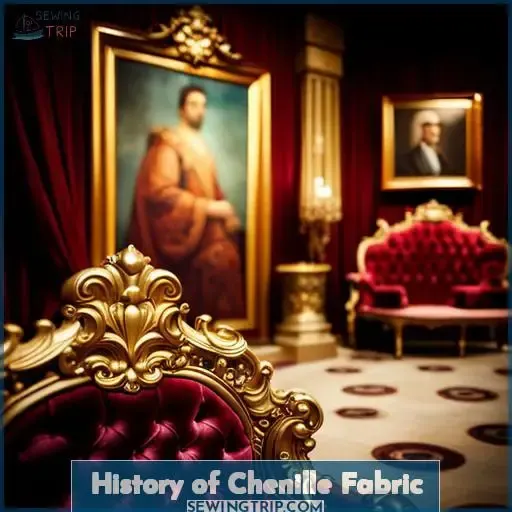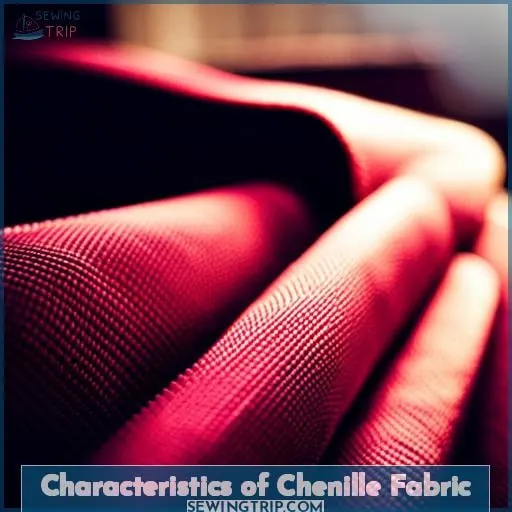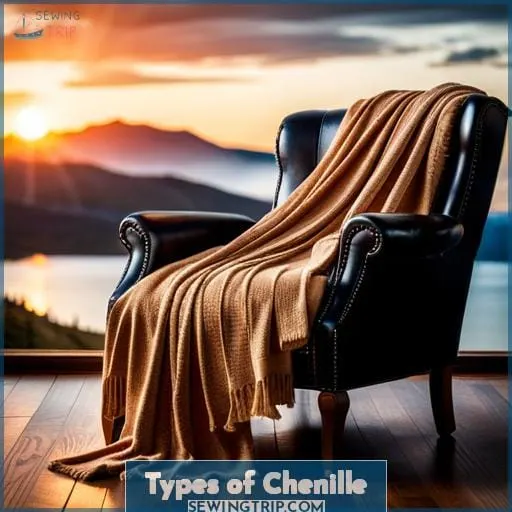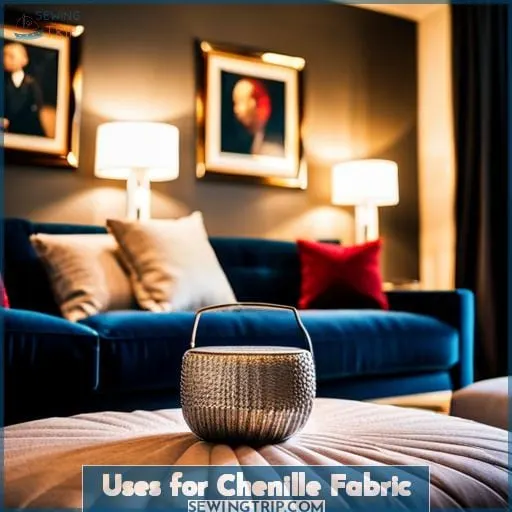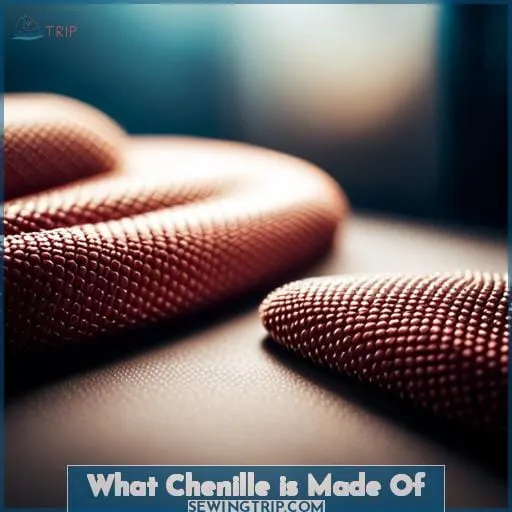This site is supported by our readers. We may earn a commission, at no cost to you, if you purchase through links.
 When clients ask for chenille fabric swatches, I know they appreciate its rich texture and versatility. Recently, a new client wanted durable chenille for bedroom curtains in her coastal cottage. The humidity and salty air posed challenges, so I suggested our medium-weight linen-cotton chenille.
When clients ask for chenille fabric swatches, I know they appreciate its rich texture and versatility. Recently, a new client wanted durable chenille for bedroom curtains in her coastal cottage. The humidity and salty air posed challenges, so I suggested our medium-weight linen-cotton chenille.
Its tight weave resists moisture while the chenille yarns’ pile traps warmth. And the fabric’s iridescence brightens up grey days.
Made of cotton wrapped around a silk core then cut into strips, chenille gets its signature look from heat setting. The caterpillar-like fibers reflect light uniquely. Chenille’s invention near Lyon circa 1760 transformed decorative textiles.
We’ve perfected its manufacture ever since. Today, chenille upholstery, accent pillows, and throws infuse interiors with cozy sophistication.
Now let’s explore the origins and qualities that make chenille so captivating.
Table Of Contents
Key Takeaways
- Chenille fabric is made by twisting and cutting yarns, with a core yarn wrapped with fuzzy yarns to create a plush texture.
- The name chenille is derived from the French word for caterpillar, reflecting its fuzzy and soft appearance.
- Chenille fabric is made from cotton, silk, and wool, blending tradition with innovation.
- Chenille fabric has a rich heritage from centuries of French weaving techniques and is known for its durability and elegant drape.
History of Chenille Fabric
Let’s explore chenille fabric’s cozy beginnings. Originating in 18th-century France, where artisans wove leno into soft, fuzzy yarn strips, the caterpillar-textured fabric found popularity in tufted carpets and fuzzy shawls before Catherine Evans revived hand-tufting in Northwest Georgia, returning chenille to its snuggly roots.
Origins and Early Development
You’d swear those little fuzzy caterpillars were creeping right over your skin when you first touched the super soft fabrics coming out of France in the 1700s.
- French artisans started weaving this fuzzy fabric by twisting and cutting threads.
- The fabric got its name chenille, meaning caterpillar in French.
- It was invented in France in the 1780s accidentally.
- The fuzzy texture came from cutting leno woven fabric into strips.
- Chenille became popular for shawls, carpets, and tufted textiles.
Chenille offered cozy softness through innovative fabrics, setting the stage for versatility in home decor and fashion.
Revival in Northwest Georgia and Hand-Tufted Textiles
You’ve noticed chenille’s hand-tufted revival in Northwest Georgia just as Catherine Evans Whitener dusted off the old technique. This spurred on the colorful, cozy rug material. Soon, spa towels and bedding companies embraced the short pile, cotton-polyester fabric.
Chenille textile production expanded but kept its manufacturing homegrown. These Northwest Georgian roots nourished chenille history.
How Chenille is Made
Twisting short lengths of yarn around a core and then cutting them creates the signature soft, velvety texture of chenille fabric. To help the piles stay intact, manufacturers use a low-melt nylon core yarn and then set the tufts in place by steaming the fabric.
Twisting and Cutting Process
Ya gotta twist those short, fuzzy yarns between the core threads, then cut ’em up into tufts for that cushy chenille feel. The caterpillar-like texture comes from twisting and cutting the colored wool tufts between low-melt nylon core yarns.
Steaming sets the pile and prevents loss during the artisanal weaving process. Core yarn provides cohesion, while the fuzzy yarns wrapped around it create Chenille’s signature look and feel when cut. It’s the unique yarn, technique, and manufacturing process that give Chenille its beloved texture.
Use of Core Yarn and Steaming
After twisting short yarns between the core yarns, you’d steam the fabric to set the pile and prevent losing tufts.
- Low-melt nylon commonly used in the core for hold.
- Steam sets twists and prevents pile loss.
- Controls shrinkage.
- Heat activates adhesive.
- Vital step ensures quality.
Without steaming, chenille would lack its signature soft texture. Proper steaming enables the fibers to maintain their pile and loft.
Characteristics of Chenille Fabric
Let us explore the special characteristics of chenille fabric. Chenille’s iridescent effect creates subtle shifts in color due to the threads being cut short. The fuzzy texture comes from multiple strands twisted together, then cut to make soft tufts resembling a caterpillar’s body.
Despite the delicate appearance, chenille is very durable with an elegant drape that holds its shape in upholstery and apparel.
Reflective and Iridescent Effect
Chenille fabric’s light-reflecting ability creates its unique shimmering, iridescent effect.
| Morning Sunlight | Candlelight | Outdoor Nighttime |
|---|---|---|
| Sparkling sheen | Soft glow | Shimmering ripples |
| Bright, crisp texture | Warm, cozy texture | Dark, fluid texture |
| Energizing visual interest | Soothing visual interest | Mesmerizing visual interest |
The fuzzy chenille yarns reflect light beautifully, whether in sunlight, candlelight, or moonlight.
Plush and Fuzzy Texture
You’d find its caterpillar-like plushness and fuzziness quite cozy. Chenille’s soft and velvety texture results from its unique manufacturing process. Short fibers twisted around a core yarn create Chenille’s distinctive fuzz. This fabric’s plush feel lends itself to practical yet creative uses, from plush bathrobes to textured pillows.
However, properly caring for delicate Chenille can prove challenging. Frequent washing may damage Chenille’s pile surface.
Durability and Drapery
You’ll love how chenille’s sturdy threads retain their shape beautifully, flowing gracefully as stunning drapes.
- Chenille’s durability comes from:
- Twisted, heat-set pile
- Sturdy, thick yarns
- Ability to hold its shape
- Resistance to fading
With proper care, chenille will last for years, draping elegantly as its pile catches the light. Luxurious hand and water absorption enhance chenille’s versatility and longevity as a fabric.
Types of Chenille
There are two main types of chenille fabric: home decor and utility. Home decor chenille features a deep, plush pile and is commonly used for items like rugs, blankets, and pillows. Utility chenille has a low pile and a tighter weave, making it suitable for apparel and furniture upholstery that requires good draping qualities and durability.
Home Decor Chenille
You’re easing into cuddly warmth when lounging on cushions of home decor chenille. Creative possibilities abound with this fabric. From artisanal techniques like hand tufting to modern manufacturing processes, chenille offers drapes, rugs, shawls, and bedspreads.
With responsible production, it brings cozy softness without a high environmental impact.
Utility Chenille
Utility chenille is made for durability, so it’s perfect for items that need to withstand heavy use. Examining material consistency shows lower attrition rates. Avoiding detrimental effects from friction makes utility chenille cost-effective.
Consumer trends favor durable chenille clothing like cardigans and gloves. Understanding chenille types and uses lets you explore printing designs on fabric swatches. With proper care, utility chenille withstands heavy use while maintaining its cozy softness.
Uses for Chenille Fabric
When it comes to chenille fabric, you’ll find that it’s extremely versatile for both home decor and clothing. From plush blankets and pillows to cozy cardigans and scarves, chenille’s soft texture lends itself well to creating comfortable statement pieces for any room in your home or for your own personal style.
Home Decor and Upholstery
You’d cozy up on the fuzzy chenille couch, sinking into its plush softness as you relax after a long day. A chenille fabric’s cushy texture envelops you in comfort. Drape lengths across windows soften sunlight.
Placed under vases, it prevents rings. Machine washing risks texture damage and distortion.
Clothing and Accessories
You’ve got chenille clothes that’ll keep you cozy all winter long.
- Sleep masks lined with chenille block out light for uninterrupted sleep.
- Chenille-lined self-heating gloves keep hands warm when temperatures plummet.
- Chenille scarves wrap necks in fuzzy warmth without risking skin irritation.
- Fiber-blended chenille cardigans add softness to knitwear staples.
- Vividly colored chenille sweaters brighten up gloomy winter days.
Chenille makes for wonderfully warm and cozy clothing and accessories to get you through winter in comfort and style.
Caring for Chenille
When it comes to caring for chenille, you’ll want to take extra precautions against common issues like stretching, distortion, and shrinkage. Chenille’s piled construction makes it prone to these problems, so follow care instructions closely to keep your chenille looking its fuzzy best.
Maintenance Challenges
You’ll find caring for chenille often requires more attention, like a high-maintenance partner.
Chenille’s luxurious texture comes at a price – its delicate nature poses cleaning challenges. The fabric’s pile traps dust and requires frequent vacuuming. Avoid over-washing, as heat sets stains and ruins drape.
Test cleaning products first, since bleach and harsh detergents damage fibers. With care, chenille rewards you with enduring beauty and comfort.
Stretching, Distortion, and Shrinkage
You’re likely to see chenille stretch, distort, and shrink if care isn’t taken. Selecting the right fibers and construction methods during processing reduces susceptibility. Hand wash in cool water with a gentle detergent, reshape while damp, and lay flat to dry.
For pilling, use a sweater comb or shaver. Proper washing, minimal agitation, air drying, and pilling removal maintain chenille’s beloved texture.
What Chenille is Made Of
You’ll find that chenille’s plush texture comes from its unique construction. Chenille yarns start with a core yarn, often cotton, rayon, or low-melt nylon for stability. Short fuzzy yarns are then wrapped around the core, creating the signature caterpillar look.
Makers test chenille’s strength and durability by rubbing the fabric vigorously. They also check absorbency by soaking swatches, wringing them out, and noting dry time. Print testing ensures patterns and images transfer properly to the pile surface.
With its cozy feel and vibrant designs, it’s no wonder chenille remains a favorite for apparel and home decor.
Frequently Asked Questions (FAQs)
What are the pros and cons of chenille fabric?
Feel the plush softness between your fingers – chenille’s comforting texture makes it perfect for cozy blankets and apparel. But the delicate fibers are prone to pilling, stretching, and distorting, requiring extra care.
Use high-quality chenille and handle gently to enjoy its warmth and beauty for years to come.
How much does chenille fabric usually cost?
As someone who has sewn with chenille for years, I understand how the cozy, caterpillar-soft fabric tempts touch with those tufted piles. But quality comes at a cost – expect to pay $10-20 per yard for the good stuff. Sure, discount chenille exists, but its thin, wimpy nap will leave you longing to be wrapped in that plush hug only the pricier fabrics can provide.
What are some tips for sewing with chenille fabric?
Use ballpoint needles and polyester thread to avoid snagging the pile. Go slowly, support the fabric’s weight, and pin often. Avoid patterns with enclosed seams, or trim the pile at seam allowances. Steam press carefully on the wrong side.
Interface collars and cuffs to prevent stretching. Hand-baste zippers and avoid bulk at seams.
How do you clean chenille upholstery?
You’ll want to spot clean chenille upholstery as needed. Use a soft brush or cloth to wipe away dirt. For deeper cleaning, use a mild detergent diluted in warm water. Avoid overly wetting the fabric, harsh scrubbing, or using bleach, as these could damage the delicate pile.
Is chenille fabric good for people with allergies?
Chenille’s soft texture may seem ideal for those with sensitivities, but the fibers it’s made from could still trigger reactions. Consider your personal allergens before using; test a swatch first to see if chenille fabric works for you.
Conclusion
As a textile expert, I know chenille’s beloved texture comes from its unique manufacturing process of twisting and cutting yarns. Some find chenille challenging to care for, but its plush softness and versatility shine whether in fashion, furnishings, or decor.
Chenille’s pedigree stems from centuries of artisanal French weaving techniques, revived stateside for tufted bedspreads. Today’s chenille retains this heritage through the materials it’s made of – cotton, silk, and wool – and innovative methods to enhance its fuzzy, caterpillar-like piles.
Discover more by delving into chenille swatches and savoring the fabric’s distinctive touch.

